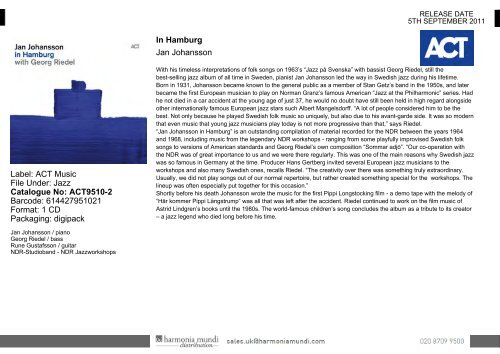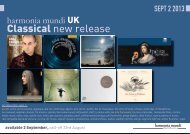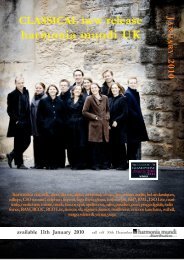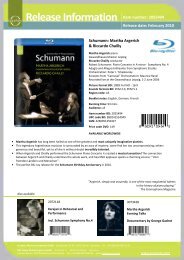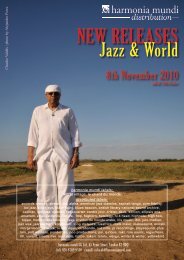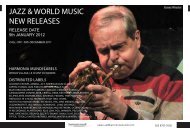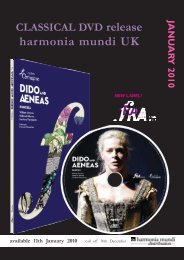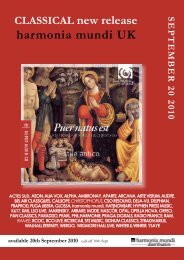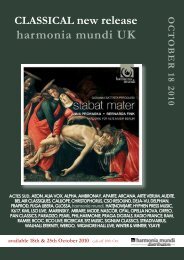jazz & world music new releases - Harmonia Mundi UK Distribution
jazz & world music new releases - Harmonia Mundi UK Distribution
jazz & world music new releases - Harmonia Mundi UK Distribution
Create successful ePaper yourself
Turn your PDF publications into a flip-book with our unique Google optimized e-Paper software.
Label: ACT Music<br />
File Under: Jazz<br />
Catalogue No: ACT9510-2<br />
Barcode: 614427951021<br />
Format: 1 CD<br />
Packaging: digipack<br />
Jan Johansson / piano<br />
Georg Riedel / bass<br />
Rune Gustafsson / guitar<br />
NDR-Studioband - NDR Jazzworkshops<br />
In Hamburg<br />
Jan Johansson<br />
RELEASE DATE<br />
5TH SEPTEMBER 2011<br />
With his timeless interpretations of folk songs on 1963’s “Jazz på Svenska” with bassist Georg Riedel, still the<br />
best-selling <strong>jazz</strong> album of all time in Sweden, pianist Jan Johansson led the way in Swedish <strong>jazz</strong> during his lifetime.<br />
Born in 1931, Johansson became known to the general public as a member of Stan Getz’s band in the 1950s, and later<br />
became the first European <strong>music</strong>ian to play on Norman Granz’s famous American “Jazz at the Philharmonic” series. Had<br />
he not died in a car accident at the young age of just 37, he would no doubt have still been held in high regard alongside<br />
other internationally famous European <strong>jazz</strong> stars such Albert Mangelsdorff. “A lot of people considered him to be the<br />
best. Not only because he played Swedish folk <strong>music</strong> so uniquely, but also due to his avant-garde side. It was so modern<br />
that even <strong>music</strong> that young <strong>jazz</strong> <strong>music</strong>ians play today is not more progressive than that,” says Riedel.<br />
“Jan Johansson in Hamburg” is an outstanding compilation of material recorded for the NDR between the years 1964<br />
and 1968, including <strong>music</strong> from the legendary NDR workshops - ranging from some playfully improvised Swedish folk<br />
songs to versions of American standards and Georg Riedel’s own composition “Sommar adjö”. “Our co-operation with<br />
the NDR was of great importance to us and we were there regularly. This was one of the main reasons why Swedish <strong>jazz</strong><br />
was so famous in Germany at the time. Producer Hans Gertberg invited several European <strong>jazz</strong> <strong>music</strong>ians to the<br />
workshops and also many Swedish ones, recalls Riedel. “The creativity over there was something truly extraordinary.<br />
Usually, we did not play songs out of our normal repertoire, but rather created something special for the workshops. The<br />
lineup was often especially put together for this occasion.”<br />
Shortly before his death Johansson wrote the <strong>music</strong> for the first Pippi Longstocking film - a demo tape with the melody of<br />
“Här kommer Pippi Långstrump“ was all that was left after the accident. Riedel continued to work on the film <strong>music</strong> of<br />
Astrid Lindgren’s books until the 1980s. The <strong>world</strong>-famous children’s song concludes the album as a tribute to its creator<br />
– a <strong>jazz</strong> legend who died long before his time.


